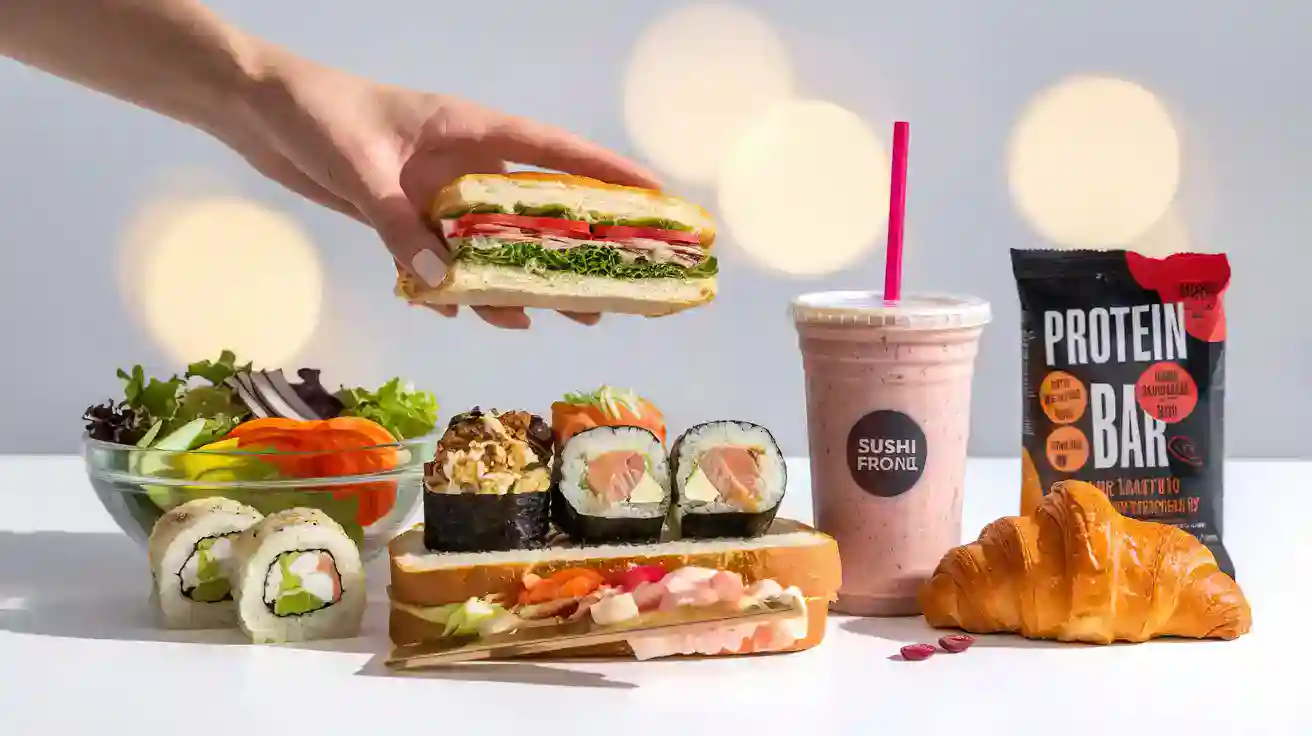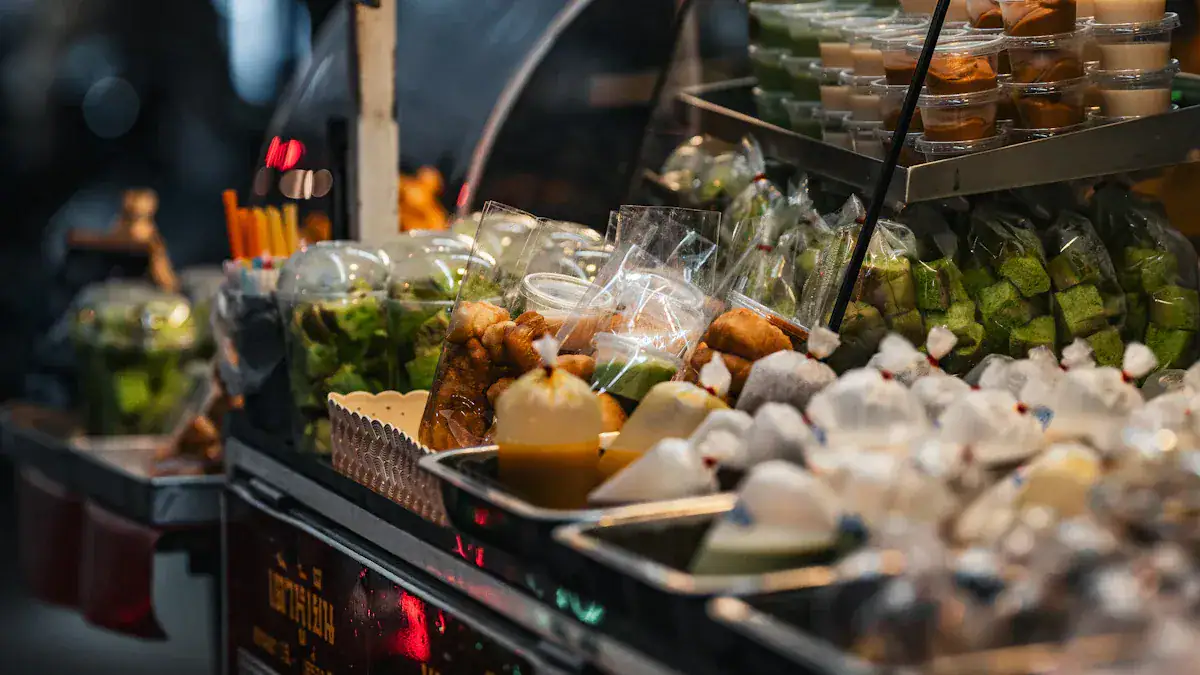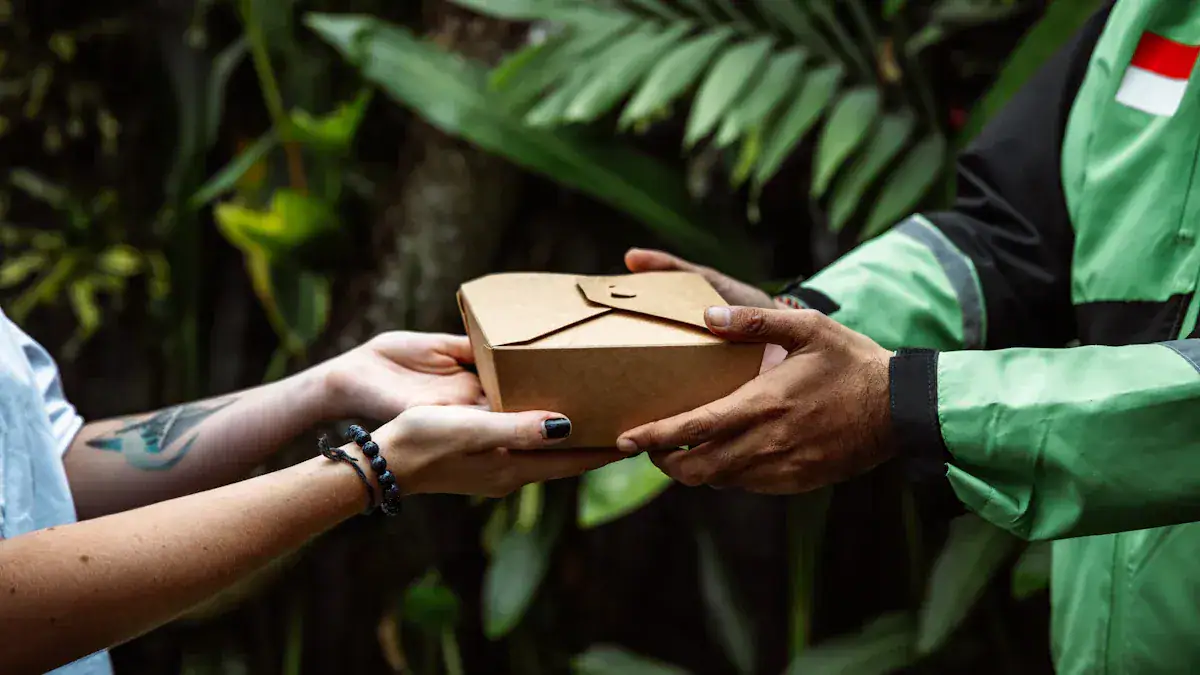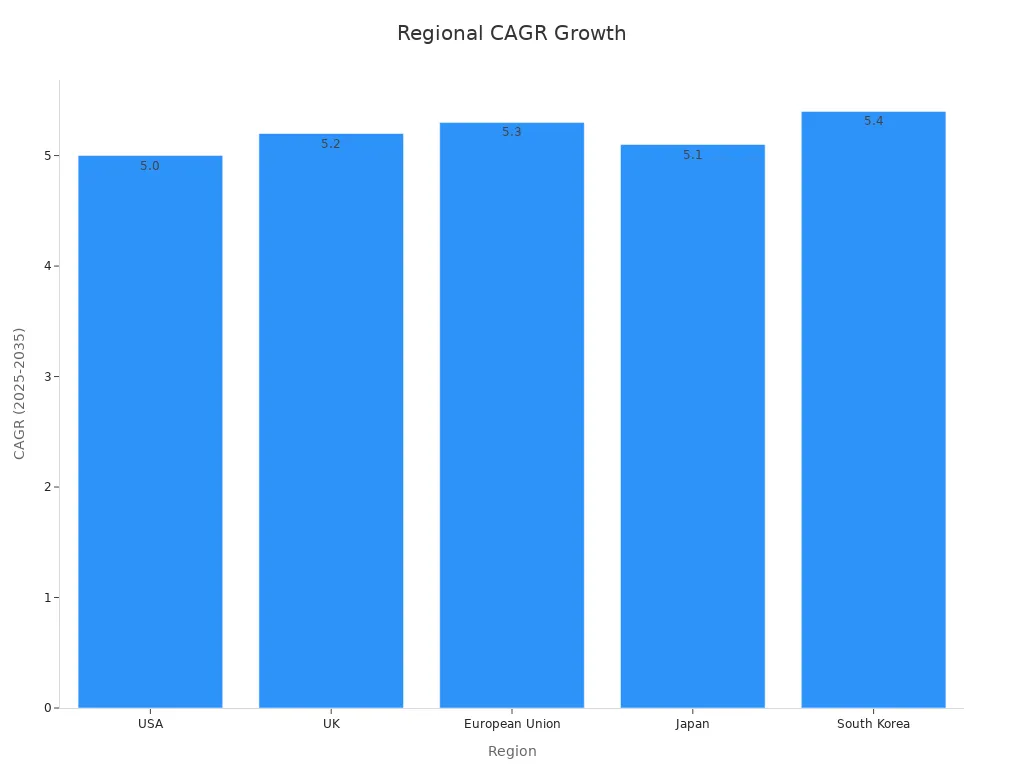What’s Hot in Grab and Go Food This Year

You see the grab and go food trend everywhere in 2025. Consumers want energy-packed snacks and nutritious meals that fit busy schedules. Over 40% of adults order delivery or takeout multiple times each month, showing just how much convenience matters. Food trends now center on portable, high-protein options like granola bars, shredded chicken, and global flavors. Businesses respond with new grab and go menus and smarter delivery apps. This shift changes how you eat and what you expect from your next quick bite.
Key Takeaways
Grab and go foods now focus on high-protein, nutritious options like protein bars, premium sandwiches, and healthy bowls to support busy lifestyles and health goals.
Global flavors from Asian, Latin, and Mediterranean cuisines add exciting variety to grab and go meals, making quick food more tasty and diverse.
Clean ingredients and eco-friendly packaging are top priorities, helping you eat healthier and reduce environmental impact with sustainable choices.
Technology like smart vending machines, app-based pickups, and heat-and-eat kits make buying and enjoying grab and go food faster, easier, and more personalized.
Flexible eating habits mean snacks often replace meals, so grab and go options now offer premium, nutritious, and convenient foods that fit your changing lifestyle.
Grab and Go Food Trends
High-Protein Snacks
You see high-protein snacks everywhere in 2025. These snacks lead food trends because you want energy, muscle support, and better nutrition on the go. Protein bars, jerky, and high-protein yogurts fill shelves in every convenience store. You also find plant-based options like pea protein chips, lentil crisps, and quinoa bites. These snacks help you manage weight, support muscle growth, and keep you full between meals. Many brands now add superfoods, probiotics, and vitamins to their products, making them even more functional.
Did you know?
Protein bars now hold over 40% of the market share for high-protein snacks. You can choose from classic whey protein, egg protein, or plant-based blends. This variety fits every diet, including vegan, vegetarian, and flexitarian.
You want snacks that are ready to eat, portable, and healthy. The COVID-19 pandemic made you more health-conscious, so you look for clean-label, low-sugar, and nutrient-dense snacks. You see new launches like MrBeast x Jack Link’s, Mini Babybel Protein, and SuperYou protein wafer bars. These products show how snack trends keep evolving to meet your needs.
Over 40% of adults order restaurant delivery or grab takeout 3-5 times a month.
38% of people say work is the main reason for ordering takeout or delivery.
Protein snacks support muscle repair, weight management, and overall health.
Plant-based protein snacks are rising in popularity for health and environmental reasons.
You can find these snacks in supermarkets, online stores, and even smart vending machines. The market keeps growing, especially in the USA, UK, and India, as more people choose healthy, convenient options.
Premium Sandwiches
Premium sandwiches stand out as a top grab and go food trend. You want more than just a basic sandwich. You look for high-quality proteins, global flavors, and specialty breads. Sandwiches now feature ingredients like Korean BBQ chicken, Thai chili tofu, or Southwest spiced turkey. You also see breads like jalapeño cheddar rolls or orange-raisin challah. These sandwiches offer generous protein portions and unique combinations you cannot make at home.
Consumer preference data shows that you care about freshness and taste, even if you wait hours before eating. You expect premium ingredients and packaging that keeps your sandwich fresh. Convenience stores and brands like E.A. Sween’s Market Sandwich respond by offering pre-made subs with top-quality meats, cheeses, and breads. These grab-and-go options meet your demand for both quality and convenience.
Tip:
Try a sandwich with plant-based protein and global spices for a new lunch experience.
Sandwich sales have soared. Nestle Professional Services reports a 35%+ increase in sandwich purchases, with breakfast sandwiches up 44%. Handheld dinner items also grew by 39%. You see more premium sandwiches in stores because you want better taste, more protein, and exciting flavors.
Nutritious Bowls
Nutritious bowls have become a must-have in grab and go food. You want meals that support your health goals, so you choose bowls packed with protein, fiber, and superfoods. Brands now offer buddha bowls, poke bowls, and acai bowls in every major city. These bowls combine grains, greens, lean proteins, and colorful veggies. You also find innovative sweet bowls and nutritious savoury bowls for every craving.
You see new products like Nestlé’s Lean Cuisine Balance Bowl, which helps with blood sugar management and weight control. Brands like Conagra’s Healthy Choice line offer bowls high in protein, low in calories, and rich in fiber. These next level bowls often carry an “On Track” badge, so you know they fit your health goals.
Bowl Type | Key Features | Popular Ingredients |
|---|---|---|
Buddha Bowls | Balanced, plant-based, customizable | Quinoa, chickpeas, kale, roasted veggies |
Poke Bowls | Fresh, protein-rich, global flavors | Sushi rice, tuna, salmon, edamame, avocado |
Acai Bowls | Sweet, antioxidant-rich, energizing | Acai puree, granola, berries, coconut flakes |
You want food that acts as medicine, so you pick bowls that help prevent disease and support long-term health. The market for prepackaged salads and bowls grows every year, with an 8.2% annual increase expected through 2028. You can find these bowls in supermarkets, cafes, and even through delivery apps.
Grab-and-go bakery products sales grew 50% over five years.
Prepackaged salad market value will top $10 billion.
The global online food delivery market will reach $1.41 trillion in 2025.
You see poke bowls and acai bowls everywhere, from fast-casual restaurants to grocery stores. Buddha bowls offer a plant-based, nutrient-dense meal for lunch or dinner. Acai bowls give you a sweet, energizing breakfast or snack. Poke bowls deliver fresh, protein-packed flavors inspired by global cuisines. These bowls fit your busy lifestyle and help you stay healthy.
Global Flavors

Asian-Inspired Bites
You see Asian-inspired bites everywhere in 2025. These foods bring bold flavors and new textures to your grab and go choices. Sushi rolls, onigiri, bao buns, and Korean fried chicken sliders fill store shelves and vending machines. You notice that Asian snacks and meals are not just for special occasions. They have become everyday favorites.
The Asian/ethnic aisle in U.S. grocery stores is growing nearly four times faster than the rest of the store.
The Asian American Pacific Islander population is the fastest-growing group in the U.S., which increases demand for authentic and fusion Asian foods.
Asian pop culture, like K-pop and anime, makes you more curious about Asian cuisine.
New Asian grocers, such as H Mart and 99 Ranch, make these foods easy to find.
You want snacks that are both convenient and exciting. North America leads the Asia cuisine market because of its multicultural population and openness to new tastes. In Asia-Pacific, rising incomes and health trends push brands to create gluten-free, vegan, and low-sugar snacks. Online delivery and social media help you discover these foods quickly.
Latin and Mediterranean Eats
Latin and Mediterranean grab and go foods are rising stars. You find empanadas, falafel wraps, hummus snack packs, and Greek yogurt parfaits in many stores. These foods offer fresh ingredients, bold spices, and healthy fats. You enjoy the mix of convenience and nutrition.
The global snack food market is growing fast, with a projected value of $838.60 billion by 2029. Europe leads with almost 30% of the market, where social snacking and on-the-go meals are common. In Latin America, countries like Brazil and Mexico turn traditional dishes into easy-to-eat snacks. Health-conscious shoppers in these regions look for natural and less processed options. The Middle East and Africa also see more demand for healthy, convenient foods as cities grow and incomes rise.
Tip:
Try a Mediterranean bowl with grilled chicken, olives, and quinoa for a filling lunch.
You see this trend in the U.S. too. Millennials want ready-to-eat, flavorful snacks that fit their busy lives. Brands respond with new packaging and plant-based options.
Fermented Foods
Fermented foods are now a staple in grab and go meals. You find kimchi, kombucha, miso soup cups, and sauerkraut snack packs in many stores. These foods support gut health and add unique flavors to your diet.
Studies show that people who eat fermented plants also eat more yogurt, kombucha, and sauerkraut.
Researchers found that fermented food eaters have different gut bacteria than non-eaters.
Lactic acid bacteria from these foods appear in your gut, which supports the health claims.
You want foods that do more than just fill you up. Fermented foods offer probiotics and other health benefits. You see more options every year, from classic pickles to new plant-based ferments. This makes it easy to add variety and nutrition to your grab and go routine.
Health and Sustainability
Clean Ingredients
You want better-for-you eating options that fit your busy life. Clean ingredients now lead the way in grab and go food. Many brands focus on plant-based choices, using ancient grains, superfoods, and probiotics. You see snacks with fewer artificial additives and more whole foods. Over half of shoppers call themselves flexitarians, so you find a wide range of plant-based proteins and smarter plant-based options in stores.
Aspect | Evidence Supporting Clean Ingredient Trend |
|---|---|
Trendy Ingredients | Ancient grains, superfoods, plant-based proteins, probiotics, adaptogens |
Clean Label Focus | Snacks free from artificial additives, preservatives, allergens |
Consumer Demand | Whole nuts, seeds, fruits, chocolate align with plant-based, vegan, paleo diets |
Market Growth | Healthy bakery snacks growing with gluten-free, grain-free, natural ingredients |
Sustainability | Snacks seen as natural, sustainable, minimally processed |
You also notice more products with naturally occurring sweeteners like beet sugar and monk fruit extract. Instant soups and snacks now highlight low sodium, organic, and vegan labels. This shift supports sustainable sourcing and helps you make healthier choices every day.
Eco Packaging
Eco packaging is changing how you buy grab and go food. You see more recyclable, compostable, and biodegradable packages on shelves. Companies use bioplastics, seaweed-based wraps, and cardboard to reduce plastic waste.
Many countries now ban single-use plastics and push for recyclable materials.
Big brands set goals to use 100% recyclable or compostable packaging.
Lighter, biodegradable packaging cuts down on fuel use during transport.
New packaging materials break down naturally, lowering pollution.
A recent study shows that packaging can reduce food waste by up to 20%. When food stays fresh longer, you waste less and help the environment. Global efforts like the UN Sustainable Development Goals encourage companies to use eco-friendly packaging. You play a part by choosing products with green packaging, supporting a cleaner planet.
Functional Foods
You look for foods that do more than just fill you up. Functional foods give you extra health benefits, like boosting your immune system or supporting heart health. These foods often include added fiber, antioxidants, or Omega-3s. You see more plant-based snacks and drinks with clear health claims, making it easy to pick what fits your needs.
Functional foods help lower disease risk and improve well-being.
You pay more for snacks with added nutrients if you trust the health claims.
Older adults and women show the most interest in functional foods.
Clear labels and familiar ingredient names increase your willingness to try new products.
You want food that supports your lifestyle and health goals. The rise of functional foods in grab and go options means you can eat well, even when you are busy. This trend fits perfectly with the move toward plant-based and better-for-you eating.
Convenience Innovations

Technology now shapes how you get your grab and go food. You see new service models that make your experience faster, easier, and more personalized. The rise of convenience culture means you expect food to fit your busy life, not the other way around. Stores and brands use smart tools to meet your needs and keep you coming back.
Smart Vending
Smart vending machines have changed the way you buy snacks and meals. These machines use real-time inventory tracking and temperature control to keep food fresh. You can pay with your phone, card, or even contactless options, making transactions quick and safe. Operators use remote monitoring to check stock levels and fix problems before you notice them.
Real-time data helps operators restock only what you want, reducing waste.
Touchscreens and digital displays let you browse options and see deals.
Machines offer dynamic discounts on items close to expiration, so you get better prices and less food goes to waste.
Smart vending uses advanced analytics to learn what you like. This means you see more of your favorite foods and new products that match your tastes. These features make your grab and go experience smoother and more enjoyable.
App-Based Pickups
You can now order your food ahead with just a few taps on your phone. App-based pickups let you skip the line and grab your meal when it is ready. Many stores use mobile payments and self-checkout kiosks to speed up the process. Some even use AI to suggest meals based on your past orders.
Tip:
Use pre-order apps during busy hours to save time and avoid crowds.
Stores use these apps to manage orders and keep track of what you like. This helps them offer better deals and keep popular items in stock. You get a faster, more personal experience every time you order.
Heat-and-Eat Kits
Heat-and-eat kits give you fresh, ready-to-cook meals that fit your schedule. You pick up a kit, heat it at home or work, and enjoy a hot meal in minutes. These kits often use smart packaging to keep food safe and easy to prepare.
Feature | Benefit to You |
|---|---|
Pre-portioned meals | No prep or waste |
Clear instructions | Easy to follow |
Fresh ingredients | Better taste and health |
You find these kits in stores, vending machines, and through delivery apps. They help you eat well, even when you have little time. Stores use sales data to update kit options, so you always see new flavors and choices.
On the Go Food Choices
Snacking Replaces Meals
You probably notice that your eating habits have changed. Many people now choose on the go food instead of sitting down for full meals. Studies show that skipping meals, especially breakfast, often leads to eating more snacks later in the day. This pattern means that snacks are becoming a common meal replacement. You might grab a protein bar or a bowl of fruit instead of a traditional lunch. Habit plays a big role. If you often snack between meals, you may find that snacks make up a large part of your daily energy intake. This shift supports the growing popularity of on the go food, especially among busy students and workers.
Segment / Trend Aspect | Data / Description |
|---|---|
Consumers eating on-the-go dishes | |
Interest in hot premium sandwiches | 28% want to try; 23% already eat them (7pp higher among foodies) |
Interest in energy/Buddha bowls | 21% want to try |
Interest in sweet bowls (acai, chia) | ~6% currently eat; ~20% want to try |
Popular on-the-go food types | Wraps, cakes, hot premium sandwiches, Buddha/Poke bowls, acai bowls |
Health trends influencing innovation | Inclusion of high-fibre ingredients, high-quality seasonal fruits and vegetables |
Consumer preferences | Demand for diverse, premium, nutritious, and visually appealing options catering to vegetarian, vegan, gluten-free diets |
Menu innovation opportunities | Emphasize health benefits, flavor variety, and presentation; use loaded fillings and innovative pairings |
Emerging premium sandwich features | Thick sliced breads, loaded fillings, trending meats (e.g., burnt end brisket, mac and cheese, fried chicken) |
Bowl ingredients | Fruits, nuts, seeds, oats, vegetables (chickpeas, kale, sweet potato, avocado), raw fish in poke bowls |
Consumer demand trend | Rising interest in innovative, nutritious, and premium on-the-go food options |
Fast Casual Rise
You see fast casual restaurants everywhere. These places offer quick service and high-quality meals. The fast casual segment grows quickly because you want convenient, healthy, and affordable on the go food. Urbanization and busy lifestyles drive this trend. You can order a meal online and pick it up in minutes. Many fast casual spots use sustainable packaging and offer a wide range of choices, from salads to hot bowls. The market for grab-and-go containers is also expanding, showing how much you value convenience.

Region | CAGR (2025 to 2035) |
|---|---|
USA | |
UK | 5.2% |
European Union | 5.3% |
Japan | 5.1% |
South Korea | 5.4% |
You benefit from fast casual dining because it fits your schedule. You can choose a meal replacement that is both nutritious and tasty. The rise of food delivery apps and AI-driven ordering makes it even easier to get your favorite on the go food.
Indulgent Takeout
You sometimes crave comfort food or a special treat. Indulgent takeout options have become more popular as people look for variety and convenience. The ready-to-eat food delivery market reached about USD 100 billion in 2023 and is expected to grow to USD 280 billion by 2032. Dinner and snack delivery segments show the strongest growth. You can now order gourmet burgers, loaded fries, or decadent desserts with just a few taps. The trend toward elevated takeout means you get restaurant-quality meals at home or work. Many companies now offer better takeout with premium ingredients and creative flavors. You might even see takeaway boxes designed for sharing or special occasions.
Note:
Indulgent takeout does not mean unhealthy choices only. Many brands now offer balanced options, so you can enjoy your meal without guilt.
You drive the demand for indulgent and premium on the go food. The market responds with new menus, creative packaging, and more choices than ever before.
Impact on Consumer Behavior
Flexible Eating
You now have more choices than ever for when and how you eat. Flexible eating habits shape your daily routine. Many people skip traditional meals and pick up snacks or takeout instead. You might grab a protein bowl for breakfast or a sandwich for a late lunch. Surveys show that ready-to-eat food consumption has increased, while frozen meals have become less popular. Nutrition information is easier to find, especially on fast-food menus, so you can make smarter choices.
Eating Behavior Aspect | Key Findings |
|---|---|
Eating Out Frequency | You eat out about 3-4 times a month, showing steady but flexible habits. |
Ready-to-Eat Food Consumption | You choose ready-to-eat foods more often, now about 2.2 times every 30 days. |
Nutrition Information Awareness | Twice as many adults now see nutrition info on menus compared to a decade ago. |
Self-assessed Diet Quality | Fewer adults rate their diet as “very good” or “excellent” than before. |
You balance convenience with nutrition. You want food that fits your busy life, but you also care about health and taste.
Business Opportunities
The grab and go trend opens new doors for businesses. You visit stores more often but spend less time inside. Many shoppers, like you, prefer quick trips and smaller baskets. Grocery stores now create special grab-and-go sections to meet your needs. Smaller stores and fresh-format markets are growing fast, especially in cities.
You make more frequent, shorter trips to stores, often to pick up takeout or snacks.
Store layouts now highlight quick-serve and ready-made meal areas.
Fresh-format stores attract remote workers looking for a fast lunch.
Convenience stores see 22% of shoppers buying grab-and-go foods several times a week.
Programs like QuickEats Heat & Eat help stores offer safe, high-quality takeout options.
Businesses that focus on safety, quality, and convenience see more sales. You expect clean packaging and easy access to your favorite foods.
What’s Next
You will see even more changes in how you buy and enjoy takeout. The market for food display warmers is growing, which means more hot, ready-to-eat meals will be available. Restaurants and stores use smart technology to keep food fresh and safe. You will notice more digital displays and energy-efficient equipment in your favorite spots.
More people choose takeout because of busy schedules and the need for quick meals.
Order-ahead and mobile apps make it easier for you to get food fast.
Menus now offer more global flavors, custom options, and new textures.
Sustainability and biotech foods become more important, giving you eco-friendly choices.
Fast food gets an upgrade with premium items and better customer engagement through apps.
You shape the future of grab and go food with your choices. Businesses respond by offering better takeout, smarter technology, and more variety.
You see grab and go food evolving fast in 2025. Freshness, health, and sustainability shape your choices, with 92% of shoppers valuing eco-friendly brands. Food trends highlight global flavors, clean labels, and smart packaging. You balance quality and price, often choosing smaller portions or premium options. The market keeps growing, with new technology and single-serve innovations leading the way. Stay curious and explore each new trend—your next meal could be both convenient and exciting.
FAQ
What are the healthiest grab and go foods in 2025?
You find many healthy options. Look for high-protein snacks, nutritious bowls, and plant-based wraps. Choose foods with clean labels and whole ingredients. Avoid items with lots of sugar or artificial additives.
How do you know if grab and go food is sustainable?
Check the packaging for eco-friendly symbols.
Look for labels like “recyclable,” “compostable,” or “biodegradable.”
Many brands now highlight their green practices on the package.
Can you find global flavors in grab and go meals?
Yes! You see Asian-inspired bites, Mediterranean bowls, and Latin snacks everywhere. Stores offer sushi, falafel wraps, and empanadas. These foods bring new tastes and variety to your daily routine.
Are grab and go foods safe to eat?
You can trust most grab and go foods. Stores use smart packaging and temperature controls. Always check expiration dates and choose sealed packages for freshness.
What technology makes grab and go food more convenient?
You use apps to pre-order meals and pay quickly. Smart vending machines track freshness and offer more choices. Heat-and-eat kits give you hot meals in minutes. Technology helps you save time and eat better.

